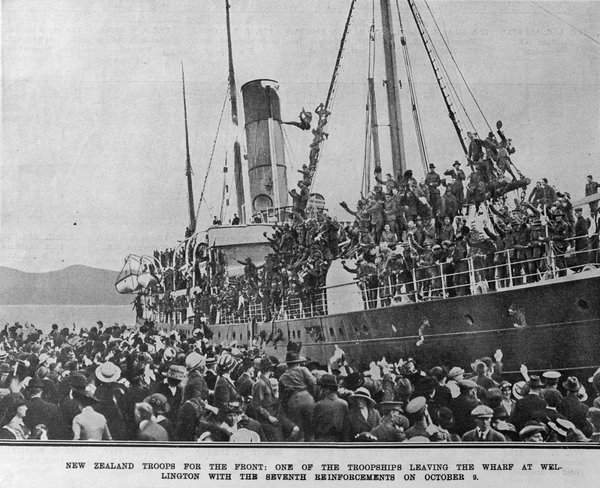Now that I have found out about my relatives at the Somme, it’s time to focus on our school project. When thinking about it back in June my French teacher, Madame de Joux, and I came up with our idea.
The name of our project is ‘Pathway to the Somme’. The plan is to recreate on a map the physical journey of some New Zealand soldiers from the Nelson/Tasman region to the Western Front. One hundred years ago in order to get from Nelson to France it plainly took a lot longer than today’s two twelve-hour flights, one one-and-a-half-hour flight and the few hours in between for stopovers. The journey on the ships were one thing, but none of the NZ soldiers were even sent straight to France. From doing my history research project in school earlier this year I learnt that the New Zealand Division at the Somme was made up of the survivors from Gallipoli, as well as reinforcements who had met them in Egypt. The newly created New Zealand Division (the first one to ever be abroad on active service) then embarked for France. So for the project we could follow those who went straight to Egypt as the reinforcements, or those who lived through Gallipoli first. The idea is to follow one group of men who had the same journey and fought the same battles, and of course fought at the Somme. The project will hopefully be completed with our partner school in France, which I will be attending for three days. I will also be staying with some people from the school when I am in France.
Being my mother’s daughter, I like to make lists. So let’s see… so far I have:
Talked to the wonderful Madame de Joux to start planning our project. We decided it would be best for a junior class to do it.
Discussed with Mr Wright (my history teacher) about the possibility of a year 10 social studies class carrying out this project either in term four of this year, or term one next year, possibly in conjunction with a French class.
*E-mailed the Nelson RSA for information.
*Attended a meeting of the Tasman South Historical Society, and explained to them my role and what I’m doing. I received some suggestions from them and we exchanged contact details.
*Found the following site from our local museum which should be very useful in finding soldiers from our region: http://ww100.nelsonmuseum.co.nz/Profiles
*Found this timeline of the war from NZ History which may also be of use: http://www.nzhistory.net.nz/war/first-world-war-timeline
I won’t actually be taking part in this project, as it will take place when I am either studying for exams or have left school (that’s a scary thought!), so my goal is just to get the project happening. But I still have quite a bit to do to even to get it started. When we go to France (in just over two weeks!!) we will each discuss our projects with our partner schools. Before then I hope to:
*Confirm, or at least discuss further, with Madame and Mr Wright which junior classes will be doing the project and when.
*Find some possibilities of soldiers to find out about. Ideally these will be ones with lots of information available, especially about their physical journey (names of ships, dates etc). The job of the junior class will be to piece all of the information together, and to create a timeline of this journey. Madame and I are thinking that their journey will be presented on a map by the students as they figure out each leg of it.
*Think about what kind of depth the students will go to in their research, keeping in mind that it will be a junior class doing the research. Mr Wright and I thought that it could be a project for the GATE class (the junior class of higher levelled learning, you could say).
*Think further about what role our partner school could play in this. This would ultimately be up to them to decide what would suit. I am thinking they could either:
- Do some investigating into the French civilians at the time, in accordance with what the NZ students find about who the NZ soldiers met, and the French towns they stayed in. While doing my research project I found a brilliant book in our school library edited by G. Harper, in which he collated letters written by New Zealand soldiers in WW1 to their families back home. Edwin Farrell wrote: “As you know, by previous letters, we worked up towards the Somme by easy marches from one village to another”. I wonder what those villages were like at that time. From other letters I know some French citizens were around, housing the NZ soldiers but presumably most of them so close to the Front had been evacuated. It would be really interesting to investigate their stories.
- Alternatively, (or along with it, depending on how keen they are) they could do their own version of what the NZ students will be doing, but instead with their soldiers and how they got to the battle. The physical distance would not be nearly as far as the NZ soldiers of course, but many of the French soldiers would have been fighting in other battles before they got to the Somme.
I have to say, it is an interesting thing setting up a project which I probably will not take part in myself. But I am still really excited for it, and whatever might come of it! I hope it will be a really engaging and rewarding way for students to research our local ancestors and their contribution to World War One, and a great way to connect with students from the other side of the world with the history we have in common.

